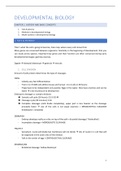Samenvatting
Samenvatting lessen, slides & handboek Developmental Biology
- Vak
- Instelling
- Boek
Volledige lesnotities + uitgebreide samenvatting van zowel de powerpoints als de hoofdstukken van het handboek Developmental Biology die aan bod gekomen zijn tijdens de les. (3e bachelor Biomedische Wetenschappen KUL) Het leren van deze samenvatting is voldoende om alle lessen te verwerken en te s...
[Meer zien]






